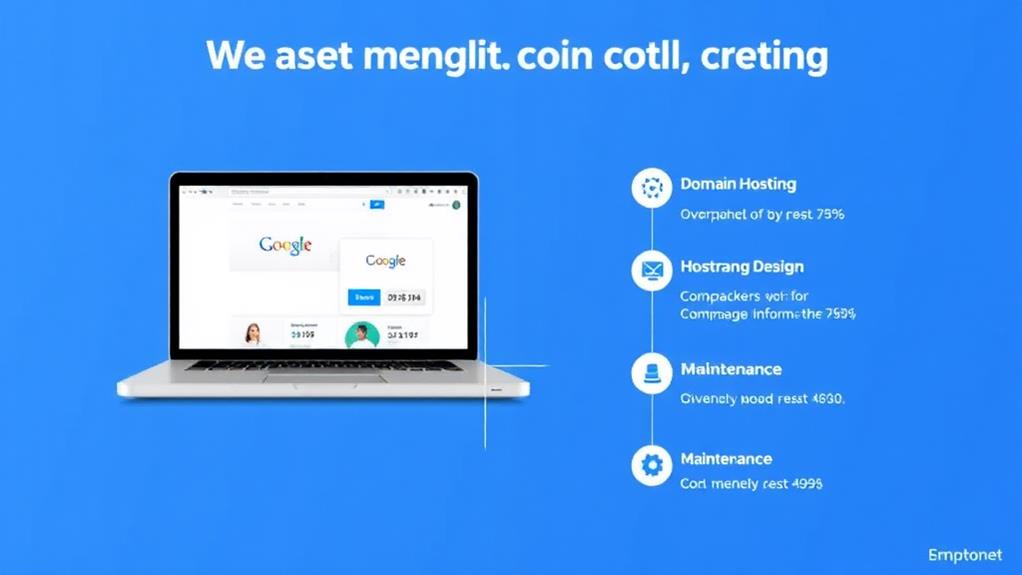When considering the cost of creating a website on Google, one must take into account various factors that contribute to the overall expense. Domain registration, hosting plans, design and development services, maintenance, and optional features all play a role in determining the total investment required. Each aspect carries its own set of costs, and comprehending these intricacies is essential for budgeting effectively. By exploring these components in detail, one can gain insight into the financial considerations involved in establishing a presence on Google.
Key Takeaways
- Costs vary based on domain registration, hosting plans, design complexity, and maintenance needs.
- Consider optional features like SSL certificates and SEO optimization for enhanced performance.
- Factor in marketing expenses for social media engagement, email strategies, and search engine optimization.
- Analyze resource allocation for design, development, and maintenance to manage overall expenses efficiently.
- Realistic timelines aligned with project scope and objectives help in cost-effective website creation.
Domain Registration Costs
When considering the cost of creating a website on Google, one important aspect to take into account is the domain registration expenses. Selecting the appropriate domain name is vital as it serves as the online identity of your website. Factors such as relevance, memorability, and brand alignment should be considered during domain name selection to ensure it connects with your target audience.
Before registering a domain, conducting a registrar comparison is essential. Different registrars offer varying prices, renewal fees, additional services, and customer support levels. It is advisable to compare registrars based on these factors to make an informed decision that aligns with your budget and requirements.
Some popular domain registrars include GoDaddy, Namecheap, and Google Domains, each offering unique features and pricing structures.
Hosting Fees
When creating a website on Google, one essential aspect to keep in mind is the hosting fees associated with it. Users have the option to choose from various hosting plans with different features and price points. Grasping the monthly hosting expenses is vital in budgeting for the overall cost of maintaining a website on Google.
Hosting Plan Options
Regularly reviewing hosting plan options is a crucial step in determining the hosting fees for a website on Google. When selecting a hosting plan, consider the following:
- SEO Optimization: Look for hosting providers that offer tools and features to improve SEO efforts. This can include fast loading times, SSL certificates, and server location options to boost website visibility and ranking on search engines.
- Security Measures: Prioritize hosting plans that include strong security measures such as firewalls, malware scanning, and regular backups. Protecting your website from cyber threats is vital to maintain data integrity and user trust.
- Scalability: Choose a hosting plan that can accommodate the growth of your website. Make sure the plan allows for easy upgrades in storage, bandwidth, and processing power as your website traffic increases.
Carefully evaluating these factors will help you select a hosting plan that aligns with your website needs while keeping hosting fees within your budget.
Monthly Hosting Expenses
For a website hosted on Google, the monthly hosting costs, also known as hosting fees, play a substantial role in the overall cost of maintaining an online presence. When considering the cost comparison of hosting plans, Google offers various options to suit different needs and budgets. Budgeting tips can help website owners manage these monthly expenses effectively.
Google's hosting fees can vary depending on the hosting plan chosen. The cost comparison between plans often involves factors like storage space, bandwidth, and additional features. It's essential for website owners to evaluate their requirements carefully to select a plan that aligns with their budget and performance needs.
To manage monthly hosting expenses efficiently, website owners can consider budgeting tips such as opting for annual payment plans that may offer discounts, monitoring traffic and resource usage to avoid overage charges, and regularly reviewing hosting needs to make sure the chosen plan remains cost-effective.
Design and Development Expenses
When considering the cost of making a website on Google, it's essential to account for design tools required and development time frame. Design tools such as graphic design software, prototyping tools, and stock images can contribute to the expenses.
Additionally, the time needed for development, including coding, testing, and refining the website, should be factored in to estimate the overall cost accurately.
Design Tools Required
To establish a successful online presence, investing in the right design tools is necessary for creating a visually appealing and user-friendly website. When considering the design tools required, there are several key factors to keep in mind:
- Design Software Options: Choosing the appropriate design software is important. Options like Adobe Creative Suite, Sketch, or Figma offer powerful tools for creating captivating website designs.
- Design Tool Compatibility: Making sure that the design tools you select are compatible with your team's workflow and the website development platform is essential. Compatibility issues can lead to delays and increased costs.
- User Interface (UI) Kits: Utilizing UI kits can streamline the design process by providing pre-designed elements like buttons, forms, and icons. This not only saves time but also ensures consistency in the website's appearance.
Development Time Frame
Starting the development phase of a website involves careful planning and strategic allocation of resources to guarantee a smooth transition from design to a fully operational online platform. Project management plays an essential role in overseeing the timeline, tasks, and team members involved in the development process. Efficient project management ensures that coding techniques are implemented effectively to bring the website to life within the desired timeframe.
To illustrate the importance of development timeframe management, consider the following table showcasing a typical timeline for website development:
| Development Phase | Timeframe | Key Activities |
|---|---|---|
| Planning | 2 weeks | Requirement gathering, scope definition |
| Design | 3 weeks | Wireframing, UI/UX design |
| Development | 6 weeks | Front-end and back-end coding |
Optional Features and Add-Ons
Various optional features and add-ons can improve the functionality and aesthetics of a website created on Google. When taking into account the cost of creating a website, it's important to factor in these enhancements that can improve user experience and overall performance.
Here are three key optional features and add-ons to keep in mind:
- Customization Options and Branding: Investing in customization allows you to personalize the look and feel of your website to align with your brand identity. This includes tailored themes, fonts, colors, and logos that can make your site stand out and leave a lasting impression on visitors.
- Security Features: Enhancing your website's security is vital for protecting sensitive data and maintaining user trust. Add-ons such as SSL certificates, firewalls, and regular security audits can help safeguard your site against cyber threats and potential breaches.
- SEO Optimization: Implementing SEO add-ons can improve your website's visibility on search engines, driving more organic traffic. Features like meta tags, keyword optimization, and sitemaps can boost your site's search engine ranking and attract relevant visitors.
Maintenance and Updates Charges
Maintaining the smooth operation and ongoing relevance of a website created on Google involves considering maintenance and updates expenses. Upkeep costs are necessary for keeping the website functioning at its best. This includes activities such as monitoring the site for any technical issues, ensuring security measures are current, and performing regular backups to prevent data loss.
Update expenses are incurred when making changes to the website to reflect current trends, update content, or enhance user experience. These expenses can vary depending on the extent of the updates required and the frequency at which they are done.
Regular maintenance and updates are vital in maintaining a professional online presence and keeping visitors engaged. By budgeting for upkeep costs and update expenses, website owners can make sure that their Google site remains competitive and continues to meet their business objectives effectively.
Marketing and Promotion Budget
To effectively reach target audiences and drive traffic to a website created on Google, a well-thought-out marketing and advertising budget is essential. When considering the marketing and advertising budget for your website, here are three key strategies to allocate your resources effectively:
- Social Media: Utilize popular social media platforms like Facebook, Instagram, Twitter, and LinkedIn to engage with your audience, share valuable content, and attract traffic to your website. Invest in targeted advertising to reach specific demographics and boost visibility.
- Email Campaigns: Develop an email marketing strategy to nurture leads, showcase new products or services, and keep your audience engaged. Personalize your emails based on user behavior and interests to enhance open and click-through rates.
- SEO Optimization: Allocate resources to optimize your website for search engines to enhance visibility and organic traffic. Focus on keyword research, on-page optimization, and quality content creation to improve your website's ranking on search engine results pages.
Total Cost Breakdown
In mapping out the total cost breakdown for a website developed on Google, it is essential to carefully analyze and allocate resources across different facets of the project. The design budget plays a vital role in determining the visual appeal and user experience of the website. Design costs may vary based on the intricacy of the layout, graphics, and interactive elements incorporated.
Additionally, the development timeline is crucial in grasping the overall cost structure. The longer the development timeline, the higher the expenses incurred for labor, maintenance, and potential revisions.
It is important to establish a realistic timeline that aligns with the project scope and objectives to ensure cost-efficiency.
Frequently Asked Questions
Can I Create a Website for Free on Google?
While Google Sites offers free options for creating websites, there are limitations to customization compared to other platforms. Users can create basic websites with templates and simple design tools without incurring costs. However, advanced features may require upgrading to a paid plan or integrating with third-party tools.
Grasping the balance between free options and customization is essential for those seeking to create websites on Google without incurring expenses.
Are There Any Hidden Costs in Website Creation?
When starting on website development, careful budget planning is necessary to uncover any possible hidden costs. Ensuring price transparency is vital to avoid unforeseen expenses that may arise during the development process. By thoroughly examining all aspects of the project, one can strategically navigate potential financial obstacles and maintain control over the budget.
Remaining vigilant and detail-oriented in evaluating costs will ultimately lead to a more streamlined and cost-efficient website creation process.
What Are the Best Strategies to Keep Website Costs Low?
To keep website costs low, consider DIY website creation platforms for a budget-friendly design. Utilize free or low-cost templates, tools, and resources available online. Opt for open-source software for added flexibility and cost savings.
Streamline the design process by planning ahead, setting clear objectives, and utilizing efficient project management tools. Regularly review and optimize website performance to guarantee it meets your needs without unnecessary expenses.
How Can I Estimate the ROI of My Website Investment?
Estimating ROI for your website investment involves meticulous cost analysis to determine the financial returns. By analyzing expenses, such as development, maintenance, and marketing, against revenue generated through conversions, sales, and leads, a clear picture of the return on investment emerges.
Factors like traffic growth, conversion rates, and customer lifetime value influence the ROI calculation. Through detailed cost-benefit analysis and tracking key performance indicators, you can accurately estimate the ROI of your website investment.
Is It Necessary to Hire a Professional for Website Maintenance?
Maintaining a website is essential for its best performance. While DIY maintenance may be appropriate for basic tasks like content updates, outsourcing upkeep to a specialist guarantees thorough support.
Specialists possess the knowledge to handle intricate technical issues, security updates, and performance optimization effectively. By entrusting website maintenance to professionals, businesses can concentrate on core operations, guaranteeing a seamless user experience and maximizing the website's potential for success.
Conclusion
In conclusion, the cost of creating a website on Google can vary greatly depending on various factors such as domain registration, hosting plans, design and development services, maintenance, optional features, and marketing strategies. As the saying goes, "You get what you pay for." It is essential to carefully consider all the expenses involved and budget accordingly to guarantee a successful and sustainable online presence.








